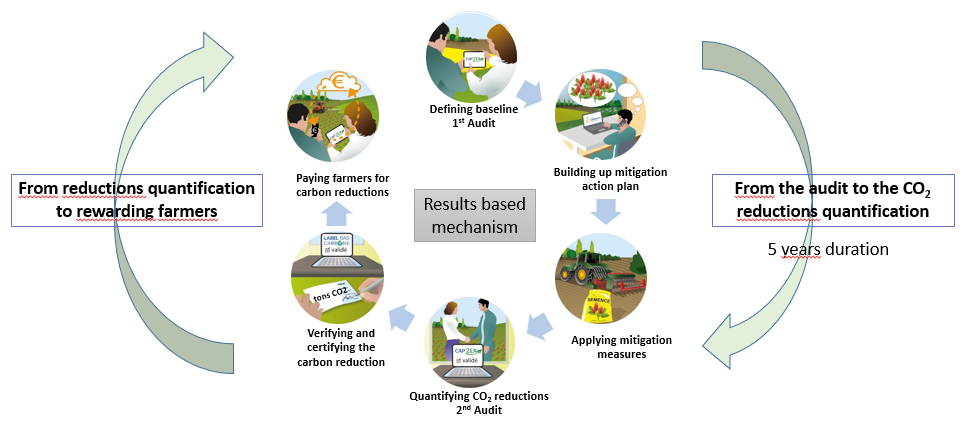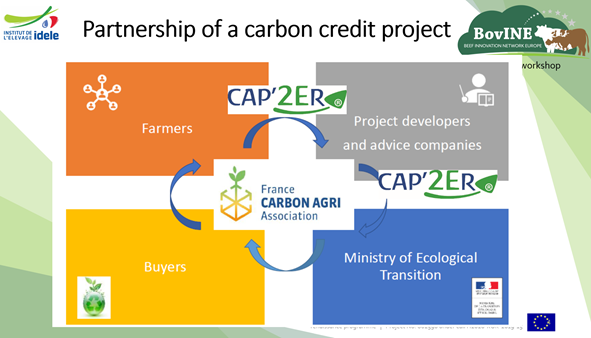INNOVATION EXPLAINED
Development and implementation of a result-based funding mechanism for carbon farming in EU beef systems.
Agriculture generates greenhouse gas emissions (GHG), (methane, nitrous oxide, carbon dioxide) responsible for climate change (10.1% of the European GHG emissions) and contributes to regulate the CO2 uptake via carbon sequestration in soils. With an aim to contribute tackling climate change, beef production objective is to reduce the carbon footprint of agricultural products using result-based funding. Carbon finance is key to incentivize and expand low carbon initiatives. The innovation aims to bring together key actors within the agriculture and other economic sectors.
Barriers in tackling climate change in beef farming sector initiatives
Facing the contribution in GHG emissions & Carbon sequestration and the objectives of the European policy, structured approaches inside the beef farming sector has been launched to tackle climate change, as the LIFE BEEF CARBON project. These projects permitted to better understand the link between agricultural practices with GHG emissions and the potential in reducing carbon intensity by 15%. The EU dimension and the number of partners involved in these projects permitted to launch a dynamic in each country for reducing carbon emissions. Despite the success of these initiatives, barriers for involving farmers and applying mitigation practices on a long-term basis have been identified:
- Barrier 1: GHG assessment methodology exists but there is no structured way of Monitoring, Reporting and Verification process to track the progress and certify the carbon reductions,
- Barrier 2: There are brakes on change linked to the risks in applying new low carbon practices, the uncertainty on yield benefit and the additional costs farmers must support,
- Barrier 3: There is no funding mechanism developed to support the application cost of mitigation practices and so to facilitate the involvement of farmers toward a low carbon beef farming.
Some rewards systems have to be found to overcome these constraints in order to develop robust carbon farming result-based mechanism. Carbon credits market is one of them.
Climate finance
Contrary to the energy and industrial sectors, agriculture and forestry are not covered by the EU Emission Trade Scheme (ETS). In the diffuse sectors especially (agriculture in general and beef especially), there is a strong need for economic tools to incentivize stakeholders in fighting against climate change. Therefore, one way to encourage emission reductions in these sectors is the development of mitigation projects financed by the voluntary carbon market, public subsidies (eg. Common Agricultural Policy), or other mechanisms (consumers based). In 2016, EU Member States represented less than 1 % of the global supply of voluntary carbon offsets in value (all sectors). The contrast is striking with the demand side, as European buyers transacted almost 60 % of the value of carbon credits on voluntary markets in 2016. This discrepancy is essentially explained by the absence of carbon standards in the EU to certify emissions reductions. Moreover, major international private standards like VCS or Gold Standard have been reluctant to certify emissions reduction projects in the EU for political reasons. Indeed, these labels' historical position on the double-counting issue has hindered the development of mitigation projects in countries that have undertaken commitments to reduce their emissions. This lack of domestic carbon certification mechanisms led several stakeholders to call for local or national standards to emerge in the EU. In France, I4CE evaluated the demand at 1.77 MtCO2e in 2015 on the French voluntary carbon market with multiple development opportunities. Final buyers are particularly interested by insetting or local carbon compensation nevertheless no mechanism has been put into practice.
Rewards beef farmers for reducing their carbon footprint through carbon credits relies in several steps.
1. Developing a harmonized farm sustainability methodology
Many investigations have been carried out in Europe to develop methodologies to assess GHG emissions and products’ carbon footprint. Following these methodologies tools have been developed like CAP’2ER in France, Carbon Navigator in Ireland, Bovid CO2 in Spain, Cool farm tool... These tools focus on GHG emissions, exceptionally on carbon sequestration (CAP’2ER) and without considering all environmental issues.
In parallel other tools have been developed to evaluate production costs, net margin… as COUTPROD in France, IDB-Rechner in Germany.
While the implementation of carbon strategies needs a complete sustainable farm analysis to evaluate the farm conditions and the possible implementation of low carbon practices, most of these tools on carbon and economic assessment are generally used separately and the social aspects are not considered. This makes even more difficult convincing farmers to adopt innovative strategies for future years.
To reduce the risk of implementing carbon footprint mitigation strategies that transfer emissions or pollutants (e.g. nitrates leaching), to evaluate the trade-offs and synergies between economic and environmental issues, to embed the social impact of the different mitigation practices (overall human well-being and quality of life): it is important to work on farm sustainability assessment covering the three pillars of sustainability. Its use in European beef farms, will permit to build sustainable mitigation carbon action plans, help farmers reduce carbon intensity and improving efficiency. This sustainability assessment will enable to monitor the GHG emission reduction, carbon sequestration increasing and carbon crediting computability.
2. Setting up a harmonized MRV framework in beef farming
One way to encourage emission reductions in the agricultural sector is to develop mitigation projects financed by the voluntary carbon market, public subsidies (e.g., Common Agricultural Policy), or other private mechanisms (agri-environmental premiums, impact investment, etc.). These sources of funding are increasingly result-based, thus requesting a transparent Monitoring Reporting Verification (MRV) framework.
Countries developed MRV systems, but nothing has been done at EU level for harmonizing the mechanism. In France a MRV framework exists to measure the benefit of low carbon practices compared to a baseline scenario. This MRV framework, based on methodologies to assess GHG emissions allows farmers to quantify their GHG emission reductions. Thanks to the certification process, part of the MRV mechanism, they will weigh the economic value of their emission reductions.
The application of a carbon farming project gathers many stakeholders: farmers, advisers, project developers, aggregators, local authority, buyers. Furthermore, the implementation of a carbon farming project was approximately 5 years for the French low carbon label and composed of different steps: farmers recruitment, certification of the project by the local authority, 1st diagnosis to elaborate the reference, construction of the carbon action plan, technical and economical advice along the 5 years, 2nd diagnosis to determine the CO2 reduction, external audit at the end of the project, labelling by the local authority. Finally, the aggregators will have to manage financial aspects and transactions with buyers and farmers regarding the CO2 reductions, the terms agreement, and the commitment for payment.
3. Determining implementation cost of carbon mitigation strategies
Recent studies (FAO) and previous European projects show that there is potential to reduce GHG emissions from the main emission sources (enteric fermentation, manure management, animal husbandry, crops and grassland management). A first evaluation of mitigation techniques costs i.e. “technical costs” has been done in several LIFE projects.
As Carbon finance mechanism requires a higher level of monitoring and evaluation which can induce high costs, it is important to determine the “private administration costs” represented by farm assessment, advising and monitoring process applied in farms. This referential cost must refer to MRV process.
4. Developing result-based carbon payment
There is a demand in carbon offset in France and in EU. The tailor-made funding processes for projects reveal the needs of the organizations which seek to make their compensation fit with their value chain and their location.
Carbon crediting exists already in French beef farms according to the figure here under with various private buyers. The projects are managed by a farmers association that merged the different carbon footprint reductions.

The dissemination in a large and concrete way of this mechanism makes carbon crediting innovation a real lever for action in the EU beef sector. Upscale to other EU countries represents an interesting opportunity for the construction of a common framework for a European beef carbon crediting strategy.
IMPACT ON FARM PERFORMANCE
Reducing beef farms carbon footprint could have various effects on farm technical and economic performance. A study (Obrien et al., 2019) analysed the potential to achieve this goal by quantifying the mitigation potential of an array of options reported in the national and international literature. Consistent with Lanigan et al. (2018), Bellarby et al. (2013) and Pellerin et al. (2017), the analysis showed many options are available to reduce beef carbon footprint, but no single option is sufficient by itself. However, some of the mitigation options identified can be applied together and are additive or synergistic. The combined mitigation potential of these additive options indicated an approximatively footprint reduction of 15% can be achieved or surpassed. Examples of reliable options that can be simultaneously implemented to substantially reduce beef carbon footprint include improving animal productivity, increasing forage quality, and enhancing soil fertility and fertilizer use efficiency. These synergistic mitigation options positively influence farm finances and are therefore likely to be adopted by farmers. They also tend to have positive affect on other important environmental impact measures, for example, ammonia (Asem-Hiablie et al., 2018). In carbon crediting initiatives commercial beef farms will aim to improve these efficiency and productivity mitigation options on along with maintaining or increasing soil carbon. The commonly recommended options to build soil carbon, for example, planting hedgerow and preserving grassland are expected to complement on-farm efficiency measures. In addition, preserving these habitats conserves cultural landscapes and enhances biodiversity (Dollé et al., 2013; Bragaglio et al., 2018).
Further mitigation of emissions is possible on-farm by using new plant species, particularly white clover, and low emission technologies, for example, urease inhibitors (Lanigan et al.,2018). These mitigation options are likely to be positive for biodiversity, but may not be additive for GHG emissions, as they have similar effects on the same emission source, mineral N fertilizer. Some low emission technology options may also cause increases in N2O emission that outweigh the benefits of reductions in other GHG emissions and reduce profitability, for example, aeration during slurry storage (Montes et al., 2013). A holistic approach is thus needed when evaluating new farm machinery (inputs) to prevent emission transfers and to avoid safety and product residue issues that could reduce the sustainability of beef farming.
AUDIO-VISUAL MATERIAL
Webinar on 'Label Bas Carbone'. Click here (French)
IDELE video at the sommet de l’élevage 2020. Click here (French)
FURTHER INFORMATION
Voluntary carbon certification and the low-carbon standard. Click here (English)
Domestic carbon standards in Europe. Click here (English)
Label bas-carbone: récompenser les acteurs de la lutte contre le changement climatique. Click here (French)